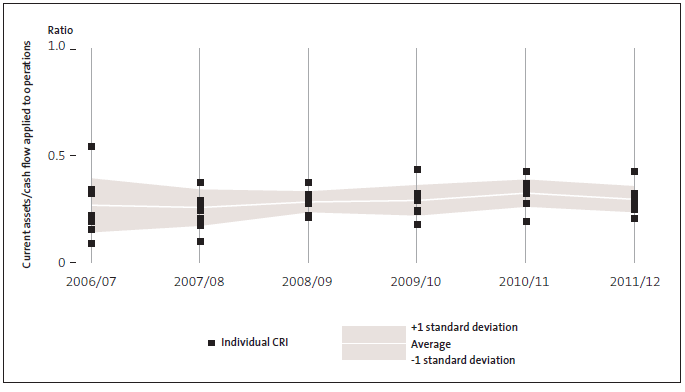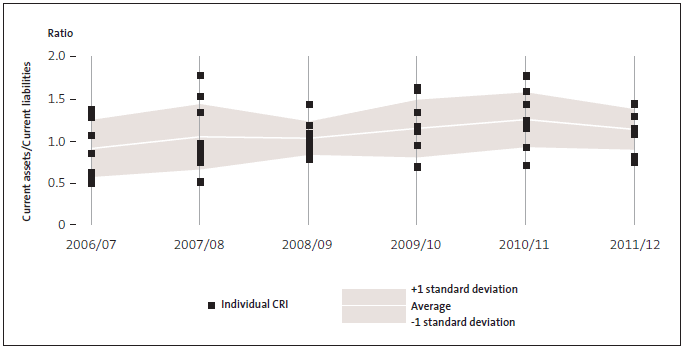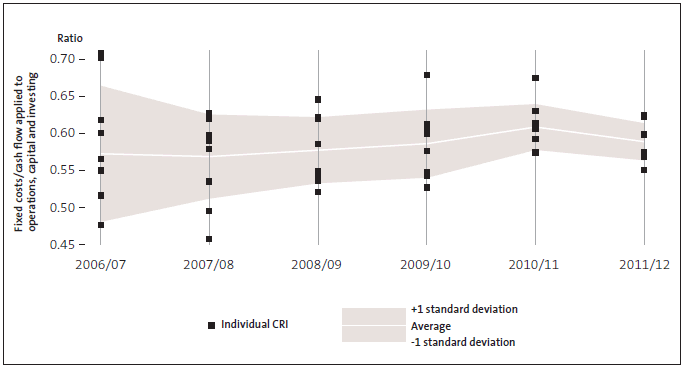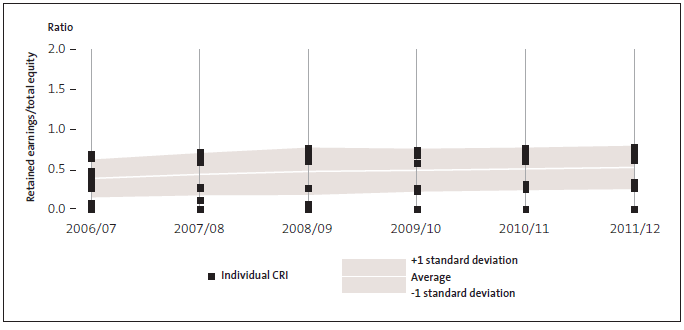Appendix 3: Our analysis of Crown research institutes' financial performance
In Part 3 we reported the findings of our analysis of CRIs' financial statements from 2006/07 to 2011/12,30 which we did in order to look at the accuracy and consistency of budget processes (stability), financial capacity to "bounce back" from unanticipated events (resilience), and financial capacity to manage longer-term uncertainties (sustainability). In this Appendix, we summarise our findings for each aspect of our analysis.31
Stability
To help understand accuracy and consistency of budget processes, we focused on comparing actual performance in two areas – operational, and assets/other investing – with budget/forecast.
Figure 11 shows the ratio32 of budgeted to actual operational cash flow for each CRI, each year, from 2006/07 to 2011/12 (marked by separate data points) and uses the average and standard deviation (SD) to summarise them.
The ratios compare CRIs' actual spend with what was originally budgeted. A ratio of 1.0 indicates accurate budgeting.
From 2006/07 to 2011/12, the sector average is consistent at around 1.0, indicating that budgets were close to actual spending. This performance has improved during the six years, with the variance of CRIs from the average decreasing more noticably in the last three years.
Figure 11
Accuracy of budgeting for operations

In contrast, Figure 12 shows the ratio of budgeted to actual cash flow applied to assets and other investing activities for each CRI, during the same period (again, with a ratio of 1.0 indicating accurate budgeting).
From 2006/07 to 2011/12, actual spending was consistently a lot less than what was budgeted for.
Figure 12
Accuracy of budgeting for assets and other investing

Resilience
For the component of financial capacity to "bounce back" from unanticipated events, we looked at the flexibility of the CRI's cost structures and the buffer provided through certain balance sheet items.
Figure 13 shows the ratio of current assets to operating cash flows for each CRI, from 2006/07 to 2011/12, and uses the average and SD to summarise them. The ratios indicate how long the operational cash flows of the entity could be supported using only current assets as funding.
A ratio of 1.0 indicates that current assets would cover one year of operating cash flow.
On average, current assets could cover operating cash flows for just over three months. These results have been stable for the last six years, and there is low to moderate variability among CRIs.
Figure 13
Potential to use current assets for operating costs

In Figure 14, a ratio of 1.0 indicates that the value of current assets is enough to cover the value of the current liabilities.
From 2006/07 to 2011/12, the sector average moves from 0.9 to 1.1, indicating that CRIs have increased their capability to cover their current liabilities with the value of their assets. Variability between CRIs is moderate to high.
Figure 14
Potential for current assets to cover current liabilities

Figure 15 show the ratios of fixed costs to cash flows applied to operations, capital, and investing. These ratios indicate the flexibility of the CRIs' cost structure. Fixed costs include only personnel costs, interest expenses, and depreciation (as a proxy for renewal capital expenditure) and amortisation.
A high proportion of fixed costs could indicate less capability to manage unexpected change by adjusting the spending of the company. Variability is moderate to high.
Figure 15
Level of fixed costs

Sustainability
For the component of financial capacity to manage longer-term uncertainties, we looked at equity to total assets, retained earnings to total equity, and capital expenditure to depreciation and amortisation.
Figure 16 shows the ratio of total equity to total assets for each CRI. A higher ratio means fewer liabilities,33 a greater level of equity, and more room to move in times of uncertainty. The proportion of equity in CRIs has followed an upward trend from around 0.60 (or 60%) in 2006/07 to around 0.68 (or 68%) in 2011/12 – a result of assets increasing at a faster rate than liabilities. Variability between CRIs is moderate to high.
Figure 16
Level of equity compared to assets

Figure 17 shows the ratio of retained earnings to total equity for each CRI. An increasing ratio can indicate long-term profitability and/or an increasing proportion of retained profits. From 2006/07 to 2011/12, the proportion of retained earnings in CRIs has followed an upward trend from around 0.39 (or 39%) of total equity in 2006/07 to around 0.53 (or 53%) in 2011/12. Variability between CRIs is low.
Figure 17
Level of retained earnings to equity

Figure 18 shows the ratio of spending on assets compared to depreciation and amortisation for each CRI. The ratios assume that depreciation and amortisation is a reasonable estimate of the amount of spending required to maintain the existing asset base. Therefore, if asset spending is above depreciation and amortisation (the ratio is more than 1.0), this is positive. However, because this also includes spending on new assets, we expect the ratio to be above 1.0, and possibly well above 1.0, in growing sectors. The ratio has been between 1.1 and 1.4 from 2006/07 to 2011/12, with moderate to high variability between CRIs.
Figure 18
Capital expenditure compared to depreciation and amortisation

30: The results for 2006/07 and 2007/08 include two CRIs that were merged to form Plant and Food Research in 2008/09.
31 The financial data collected represents the financial activities of the parent organisation and does not include any subsidiaries. There are advantages and disadvantages in doing this, but on balance we consider that this is appropriate for the analysis. This is because, among other things, comparability across the public sector is important and materially large subsidiaries can then be analysed separately. For CRIs, we have not included any separate (and material) subsidiary information in our data set, but we may do so in future years. As an example, NIWA Vessel Management Limited (which owns the Tangaroa) has not been separately included. However, using NIWA's group accounts would not have materially changed our overall findings or conclusions about CRI's stability, resilience, or sustainability.
32: The term ratio refers to the relationship between two numbers of the same kind. In this report, we compare two accounting line items within the financial statements by dividing the two items, then we express the resulting ratio as a number – for example, 1.0.
33: Equity plus liabilities equals assets.
page top
